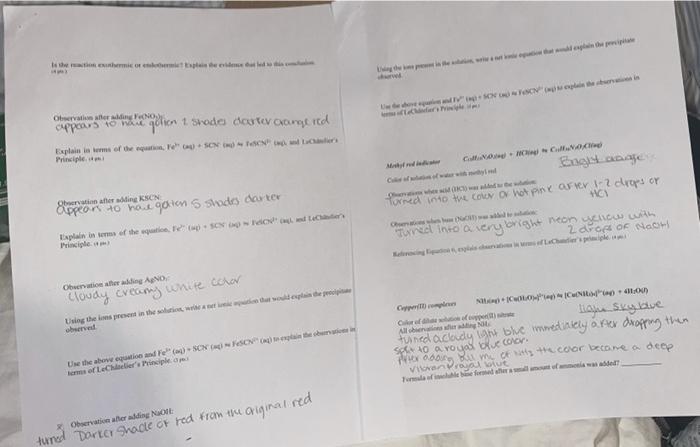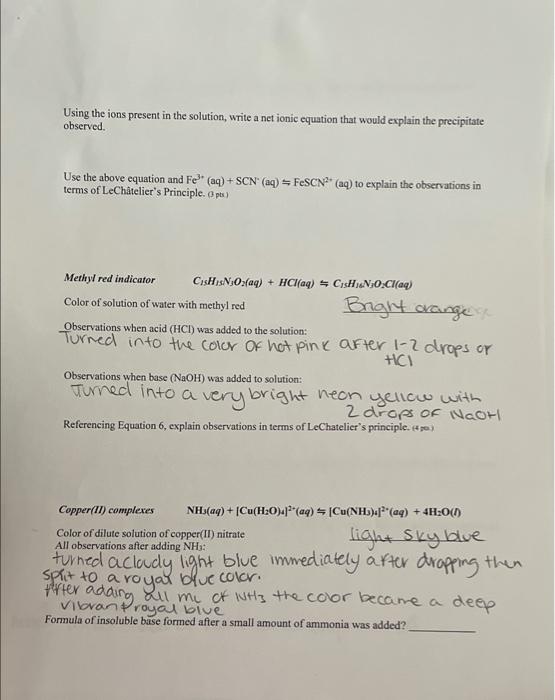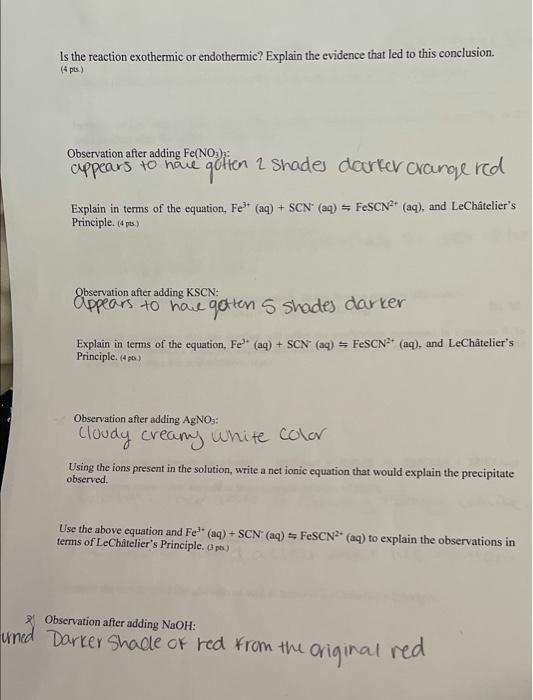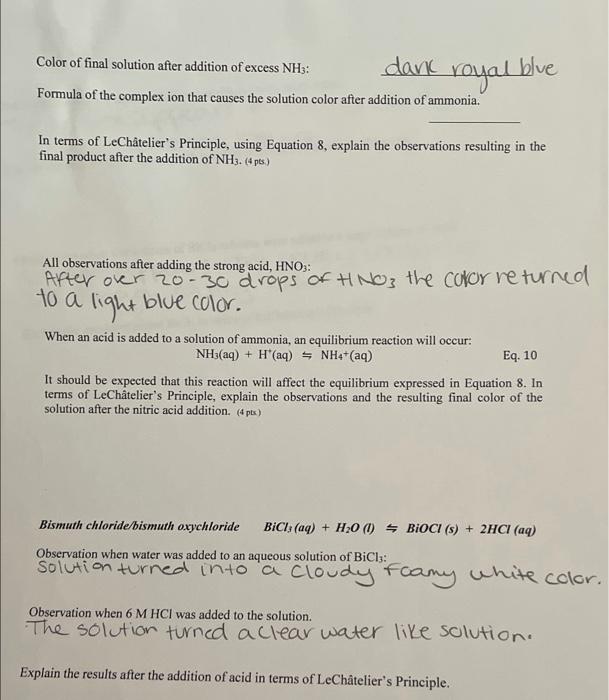please help me fill in the blanks of all pages using the info form the singlenpage picture
In the mic w . Observatie ter Adding appears to na golion 1 skodes doute ang red Explain in mms of the SONA Principles rain KSON oppeor to have gaion 5 Shades carter GOV. Bright ange formed into the com o hot pink are drops or HON Tured into a very lonight neon cui 2 ovo O MOC Explain in tem of the Swat Principles Obvestering AND cloudy creamy white color Using their present in the work that was place the religious Cypt bed vesc cagi mo the sun is NICNIM 411.00 Lion Skylle NL tuned aclaudy ght blue medinely rter dropping then So a roya Rue coor Pero Bum of the coor become a deep Vienu but the the above equatico madre" (0) SON crm of theire Principles Not tuned Darter Shade of red from the original red (Except where otherwise noted, 2 pts for cach answer) Dinitrogen tetroxideitrogen dioxide N20 (8) +57.2 kJ = 2NO3(g) Room temperature bath Observations: Dark Brown, not easily seen through Ice water bath Observations: Temperature 250 Temperature light brown easy to see through Temperature 670 ery Dark Brown, Barely able to see through NO Brown Hot water bath Observations: > Color: NO4 colorless Explain the evidence that led to the color determination: Which gas is responsible for smog? What time of year would you expect smog caused by this gas to be worst? Explain. Iron(III) thiocyanate complex: Color: Fe(NO3), solution Fe+ (aq) + SCN (aq) = FeSCN- (aq) Clearlcolorless KSCN solution dark orange red [Fe(SCN)]" solution dark ved Dark Brown Blood like" The Color turned a little darker and brighter, a more vibrant color. Observation after heating: Turned a very light pastel like orange color Using the ions present in the solution, write a net ionic equation that would explain the precipitate observed. Use the above equation and Fe (aq) + SCN" (aq) = FeSCN2(aq) to explain the observations in terms of LeChtelier's Principle. O pes) Methyl red indicator CsHsNOxfaq) + HCl(aq) = CH.N.O.Cl(aq) Color of solution of water with methyl red Bright orange Observations when acid (HCI) was added to the solution: Turned into the color of hot pine after 1-2 drops or HCI Observations when base (NaOH) was added to solution: Turned into a very bright neon yellow with Of Referencing Equation 6, explain observations in terms of LeChatelier's principle. (e) Copper(II) complexes NH(aq) + [Cu(H2O) ] (aq) = [Cu(NH3)/(aq) + 4H2O Color of dilute solution of copper(II) nitrate All observations after adding NHO: light sky blue turned a cloudy light blue immediately after drapping then spiertad a royar blue color perter adding all me of lutts the color became a deep vibran &royal blue a Formula of insoluble base formed after a small amount of ammonia was added? Is the reaction exothermic or endothermic? Explain the evidence that led to this conclusion. (4 pts.) Observation after adding Fe(NO) appears to have quilten 2 Shades darker crangered Explain in terms of the equation, Fe+ (aq) + SCN" (aq) FeSCN- (aq), and LeChtelier's Principle. (4 pts. Observation KSCN: appears to have gotten 5 Shades darker Explain in terms of the equation, Fe (aq) + SCN (aq) FeSCN- (aq), and LeChtelier's Principle. (p Observation after adding AgNO3: Cloudy creamy white color Using the ions present in the solution, write a net ionic equation that would explain the precipitate observed Use the above equation and Fe (aq) + SCN (aq) FeSCN- (aq) to explain the observations in terms of LeChatelier's Principle. pes) Observation adding NaOH: uned Darker Shade of red from the original red Color of final solution after addition of excess NH3: dank Formula of the complex ion that causes the solution color after addition of ammonia. royal blue In terms of LeChtelier's Principle, using Equation 8, explain the observations resulting in the final product after the addition of NH3. (4 pes) All observations after adding the strong acid, HNO3: After over 20-30 drops of HNO3 the color returned to a light blue color. When an acid is added to a solution of ammonia, an equilibrium reaction will occur NH3(aq) + H(aq) + NH4+(aq) Eq. 10 It should be expected that this reaction will affect the equilibrium expressed in Equation 8. In terms of LeChtelier's Principle, explain the observations and the resulting final color of the solution after the nitric acid addition (4 pts) Bismuth chloride/bismuth oxychloride BICI: (aq) + H20 (1) 4 BIOCI (s) + 2HCI (aq) Observation when water was added to an aqueous solution of BiCls: solution turned into a cloudy Foamy white color. Observation when 6 M HCI was added to the solution. The solution turned a clear water like solution. Explain the results after the addition of acid in terms of LeChtelier's Principle













